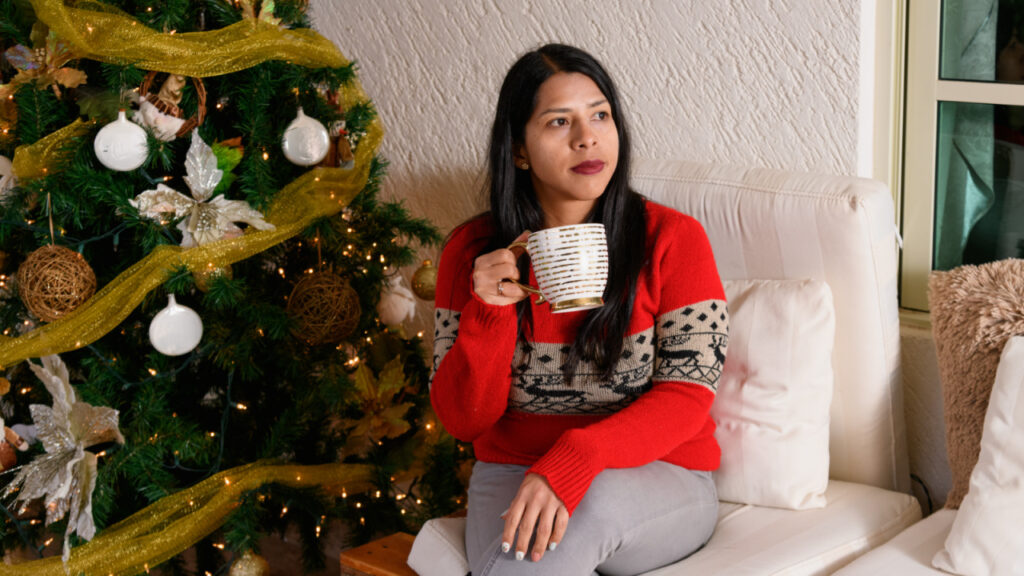Hold Up, That’s Not What an ‘Almond Mom’ Is: Busting the TikTok Myths
Latina almond moms have been trending hard on TikTok. Under the hashtag, which has millions of views, women show off their mom’s “almondiest” habits. Users show pantries full of things like chia seeds, bulk herbs, teas, and superfoods. Others show coconut oil, bags of flaxseed, honey, oatmeal, almond butter, quinoa, whole wheat bread, an underlying aversion to sugar, and more. Generally, it’s talking about foods that are considered “healthier”.
Here’s the thing. We’ve got it all wrong. This is not what an almond mom is, and it’s making me silently pissed off.
An almond mom is actually a very problematic concept
She represents toxic diet culture, which is itself based on a meme that began after a 2013 episode of Real Housewives of Beverly Hills. In the scene that launched a thousand memes, socialite Gigi Hadid tells her mom that she feels lightheaded after eating just half an almond, to which her mom replies, “Just chew your almonds well.”
An almond mom cuts calories by cutting out food (think only eating half a banana because, calories!), emphasizes toxic diets and being the lightest weight possible, over wholesome, nutritious eating that’s good for your health. She also has the habit of shaming her kids about their bodies, which research shows can have a very negative impact and lead to eating disorders and depression.
Dr. Karla Lester, a board-certified pediatrician who talks about eating and health for young people on TikTok, says on a video that almond mom culture is “rooted in internalized bias, fatphobia, fear pursuit of thin privilege and not health” and is likely an extension of the parent’s own eating disorder.
These videos of Latino pantries and fridges don’t really show almond mom eating, which usually looks like a nearly empty fridge—maybe a stalk of celery here and a green juice there. Because almond moms barely eat! Quinoa is not diet food, and neither is oatmeal or cacao. It’s nutritious food that our people have been eating for centuries.
As I researched my book about señora habits and rituals, I was reminded of how incredibly beautiful, wholesome, and influential our cultural food history is.
Your Abuelas ate the “Mediterranean Diet” before it was trendy
First, people in our homelands, starting with Indigenous People and through the señora period, have long eaten simple, good foods. These included veggies, fruit, beans, corn, whole grains, nuts and seeds, coconut, good oils and healthy fats, herbs, teas, and little to zero added sugar.
In fact, your Abuela likely ate a lot like the now glamorous “Mediterranean diet.” Your great-grandmother probably had a veggie huerto (garden) or fruit orchard out back where she went “shopping.” She probably even got fresh eggs from her own chicken coop or the señora down the street and made her own delicious cheese.
The diet of Indigenous People in Central America is Mesoamerican in nature and generally consists of things like corn, beans, squash, chili peppers, nopal, tomatoes, Amaranth, Chia Seeds, fruits like Papaya, herbs like epazote and achiote, and much, much more. Traditional diets of the Indigenous People where I come from in South America include quinoa, beans and legumes, small game, wild berries like maqui, sweet potatoes, small potatoes, fruits like Murta (Chilean Guava), Calafate (similar to blueberries) and lots of seafood.
Many people—especially older folks—generally eat well in our homelands. However, this is sadly changing as more folks start relying on takeout food and corporations coming in from other countries (ahem, McDonald’s).
I am sure you’ve talked to friends or family who return to their ancestral homelands, start eating in a completely different way than what they’re used to here in the U.S., and instantly feel their health improve. This is only an observation, but I have heard from multiple people that they can digest the bread better when they visit Latin America. And how many Tías in your homeland don’t even put sugar in their coffee or tea?
The truth is, our ancestors were herbalists
Using a variety of herbs does not in any way signify having an eating disorder. Your great-grandmother’s pantries were likely full of herbs, and they may have had intimate knowledge of the health qualities of teas (and used them as remedios). In fact, you likely had a relative who was an herbalist. This is particularly true if your family is Indigenous or Mestizo because many Indigenous People of Latin America discovered and harvested some of the herbs now considered wellness staples throughout the world.
Señoras of the past and present love their tecito. For example, Chamomile (te de manzanilla) is an abuela’s favorite relaxing tea. Other teas include boldo, mate, Rue tea, Te de Tilo (Linden Flower tea), and agua de Jamaica. All these and more will do things like soothe your belly, help you fall asleep, or help you feel better during your period.
Almond moms drink…detox teas.
They also were the backbone of the wellness culture
Several ingredients typically associated with wellness culture actually originated in our homelands. For example, quinoa comes from countries alongside the Andes (Chile, Peru, Bolivia, Ecuador). Cacao was peeped first by the Olmec civilization (1500 to 1400 BCE). They were the first to domesticate the cacao tree and create ceremonial drinks, followed by the Mayas and Aztecs, who even used it as a form of currency. It wasn’t even sweet. The Spanish were the ones who added sugar to it.
Avocado has been a Latin American staple for centuries, particularly in south-central Mexico. Some stories suggest that Chilean and Peruvian miners may have brought the idea of avocado toast (“pan con palta”) to the U.S. during the Gold Rush, but there is no known hard evidence of this.
I remember eating avocado toast in Chile when I came home from school. Then, somehow, it made its way to Erewhon cafe. Back then, avocado toast was the “toast” of U.S. wellness culture. Cassava, which you’ll see as flour in some “almond mom” pantries, originated in Brazil and other parts of South America. Acai berries come from Brazil. Maca root, which is also added to smoothies as a superfood, comes from Peru.
Lastly, when I talked to Registered Dietitian Krista Linares RD, from Nutrition Con Sabor, I learned that many of our cultural foods are indeed healthy. Things like beans, tortillas, plantains, and even white rice are nutritious and good-for-you foods.
Unfortunately, many food traditions are lost when your family immigrates to another country. Some research shows that once families move to this country from their homelands, the more acculturated we become, the less we eat whole foods, fruits, and whole grains. Instead, we start to eat more junk foods and overdo it with sugar.
For their part, almond moms think all “Latino food” is unhealthy because the only way they experience our foods is at restaurants with massive servings.
Before buying the whole ‘Almond Mom’ myth, just remember our Mamis are natural shoppers
It’s not just almond moms buying at the natural grocery stores. Latinas are buying more “natural” food than other consumer groups (their terminology, not mine). I know that when I go into my local indie natural food market, a good half of the customers are Latina moms and señoras gathering their weekly groceries.
In one study, 82% of U.S. Latinos who were surveyed preferred fresh foods over packaged foods. Farmers markets, where all things fresh and high quality live, were also a favorite of our ancestral señoras, better known as the mercados.
What are some good tips for eating like your ancestors—and not an almond mom?—Certified Nutritionist Cat Edgerton, C.N., says to eat “in a way that prioritizes real, whole foods and not overcomplicating your diet.” Read the ingredient lists, eat dark leafy greens and fiber-rich veggies, lean proteins, and healthy fats at every meal “to keep your blood sugars from spiking.”
Eat fruit and veggies in season by familiarizing yourself with seasonal harvests on websites like SeasonalFoodGuide.org. Then, head to Trader Joe’s for their organic ground turkey, organic veggies, frozen berries, and wild-caught seafood.
I know there are almond moms in every country and culture, and some Latina moms may very well veer into the unhealthy “Are you sure you’re gonna eat that second cookie?” category. But in general, our moms and grandmas are not that extreme. What’s more, wellness staples, nutritious ingredients, and so-called “superfoods” are part of your cultural heritage—and that should make you really proud.
Chilean-American Ann Dunning is the co-author of Radical Señora Era: Ancestral Latin American Secrets for a Happier, Healthier Life, which is now available for pre-order wherever books are sold. She’s also the co-founder of the Latina-owned rosehip line Vamigas.




